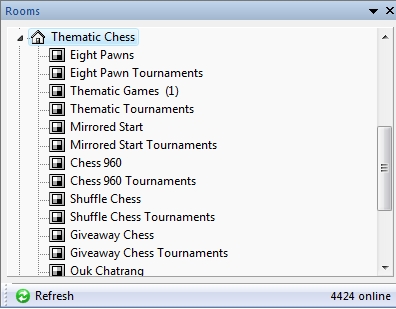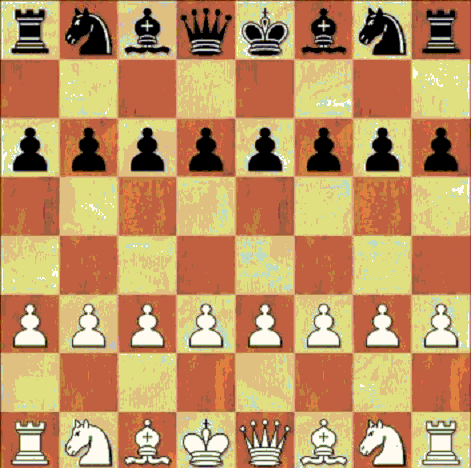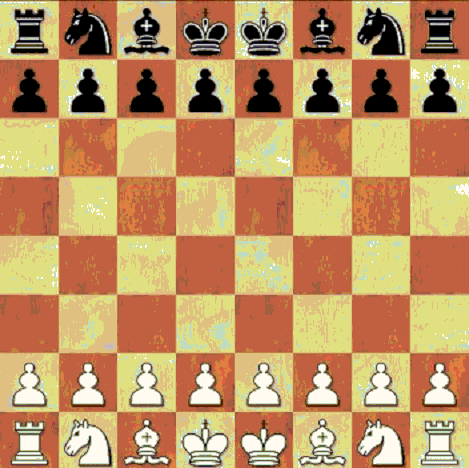|
Thematic chess |

|

|
|
|
Thematic chess |

|

|
Thematic chess
The Playchess server supports a number of variations of chess. These are to be found in the Thematic chess rooms.

![]() In the Eight pawns room the games are played with eight pawns and no pieces.
In the Eight pawns room the games are played with eight pawns and no pieces.
![]() The Shuffle chess room is for Fischer Random chess, without the special castling rules. There are 960 different start positions, and every day a new one is chosen at random.
The Shuffle chess room is for Fischer Random chess, without the special castling rules. There are 960 different start positions, and every day a new one is chosen at random.
![]() Thematic games start with a specific opening. Any player who has at least the rank of Bishop can enter the theme moves by starting a new broadcast in the Thematic games room. You can also enter a position from which the games can start.
Thematic games start with a specific opening. Any player who has at least the rank of Bishop can enter the theme moves by starting a new broadcast in the Thematic games room. You can also enter a position from which the games can start.
The Thematic chess rooms are not visible to visitors with older versions of the program.
Eight Pawns
The Eight pawns games is played with eight pawns and no pieces.
Shuffle Chess
The only difference between Shuffle Chess and classical chess is the starting position. The pieces can be set up in any one of 2880 starting positions, which can be selected with a dialog box. This chess variant means that theoretical knowledge is not as important as the flexible evaluation of a position. Very unusual positions can appear on the board, demanding greater tactical amalysis from the players.
Ouk Chatrang (Cambodian Chess)
The game Ouk Chatrang has several differences to classical chess.
The game is played on an 8x8 board, but the squares must not necessarily have different colours. The aim of the game is to checkmate the king, as in classical chess. Stalemate is rated as a draw.
The pieces have different names. King, Queen, Rook, Bishop, Knight and Pawn are called respectively:
Ang or Sdaach (King)
Neang (Queen)
Tuuk (Board)
Koul (General)
Ses (Knight)
Trey (Fish)
There are two differences in the starting position. All the fish (= pawns) are placed on the third rank. The king is always placed to the left of the queen. The following diagram shows the starting position of Ouk Chatrang.

The moves
1. The Trey (Fish) moves the same way as pawns in classical chess. They advance one square forwards and captures are carried out one square diagonally. There is no double-square advance, and so there is no En Passant rule. On reaching the enemy’s front line (the sixth rank for White and the third rank for Black) the fish becomes a Trey Bak. This piece moves identically to the Neang (Queen), and so the only difference is in the name.
2. The Ses (Knight) moves exactly like the knight in classical chess.
1. The Koul (General) can move one square forwards or one square diagonally in any direction. That means that this piece has at most five legal moves.
2. The Tuuk (Board) moves exactly like the rook in classical chess.
3. The Neang (Queen) can move one square diagonally in any direction. For its first move it can move two squares forwards, for instance from e1 to e3.
4. The Ang or Sdaach (King) moves exactly like the king in classical chess. There is no castling, but for its first move it can move like a knight, as long as it is not in check.
Every legal move can be used to capture a piece. As in classical chess, the piece is moved onto a square occupied by an enemy piece, which is then removed from the board.
Additional Rules
A draw can come about through the following circumstances:
1. The agreement of both players
1. Insufficient material for checkmate
2. Stalemate
1. Threefold move repetition
Twin Chess
The starting position in Twin Chess is the same as in classical chess, with one important difference. Neither side has a queen, they both have a second king which is placed in the queen’s position. A player does not have a queen unless he can promote a pawn.

It is possible for a king to be captured, ie it can be removed from the board. The first player to lose both kings has lost the game. All the other rules and moves are the same as in classical chess. Both kings can do a short castle on their respective sides. Long castling is possible on either side after the other king has been moved away.